MSI 845 Ultra ARU Review
Introduction
Intel seem to be dominating the chipsets we've seen recently at Hexus and it's been a while since we saw a Socket A AMD solution. This continues today with the i845-D implementation of MSI's excellent 845 Pro2 motherboard. If you cast your mind back you'll notice that we liked the 845 Pro2 a lot with it being the best of the 3 i845's that we tested.
It packed a lot in with 6 PCI slots plus hardware RAID and the excellent C-Media CMI8738 chip to provide on board sound. All of that on MSI's now common red PCB and they managed to cram it onto a 6 mount ATX layout too. Compact, full of features and the fastest of the i845's we tested.
Have they managed to do the same with the Ultra ARU? The Ultra brings with it a few changes to the layout, the most noticable being the loss of a PCI slot, however the feature set has increased so it balances things out to some degree and depending on how you value you the features, may actually even tip the scales in favour of the new board.
We'll come to those in a second but first a quick look at the new chipset. The ICH2 Southbridge is present and correct and the 593 pin FC-BGA MCH/Northbridge is also present but this time supporting 200/266Mhz (PC1600/PC2100) DDR memory instead of PC133 SDRAM that we saw in the 845 Pro2.
When we reviewed the 845 Pro2 we couldn't help but comment on the fact that despite being a good board, that the P4 is somewhat starved of the memory bandwidth it craves. PC133 SDRAM can only provide 1.06Gb/sec at 133Mhz against the 3.2Gb/sec of PC800 dual channel RDRAM or here with 2.1Gb/sec from PC2100 DDR memory.
While PC2100 DDR is still a fair bit short of providing the same amount of bandwidth or PC800 RDRAM, does the P4 really need so much bandwidth in real world situations and can Intel's DDR chipset keep up with RDRAM?
While the P4 might need a smidge more bandwidth that 2.1Gb/sec in some situations, for DDR to work well with the processer it must be a pretty good bet that the majority of tasks you ask the CPU to do must fall into the sub 2.1Gb/sec category.
Hopefully our benchmarks will confirm our theory. The i845 has actually supported DDR memory since day one however on launch they only released the chipset with support for SDR SDRAM. It's only now, when SiS with the SiS645 and VIA with their P4X266 and P4X266A chipsets, both supporting DDR memory (DDR333/PC2700 in the case of the SiS645) that Intel have entered the same arena with their own DDR P4 chipset.
So lets see what MSI bring to the table with their implementation. Do they have what it takes to beat the competition with this board too?
MSI 845 Ultra ARU
CPUAs you can see the 845 Ultra ARU is positively packed with features. Being the ARU version of the board we have the full compliment of features, A standing for on board audio, R for onboard RAID and U for USB. The CMI8738 we've seen before from MSI and it's an excellent audio solution. The USB is actually USB 2.0. USB 2.0 increases on the 12Mbit/sec interface seen on USB 1.1 by a factor of 40. At 480Mbit/sec (60Mbyte/sec) it provides a proper high speed bus interface whereas USB was rather slow at 1.5Mbyte sec. USB 1.1 is fast enough for digital camera, some printers and low bandwidth devices whereas USB 2.0 now has the potential to support a larger range of devices for which 1.5Mbyte/sec isn't enough like high speed CD-Writers and hard disks that use a lot more bandwidth than USB 1.1 can provide.
Supports Intel Pentium 4 processor in 478 pin package
Support 1.5GHz to 2.2GHz processors and up
Chipset
Intel 845 chipset (593 FC-BGA)
Supports DDR SDRAM at 200/266MHz operation (DDR200/DDR266, PC1600/PC2100)Intel ICH2 chipset (360 EBGA)
AGTL+ host bus with integrated termination supporting 32-bit host addressing
1.5V AGP interface with 4x data transfer and 4x fast writes
8-bit 66Mhz 4x hub interface to Intel ICH2Upstream hub interface for access to the Intel MCHMain Memory
2-channel Ultra ATA/100 Bus Master IDE controller
USB controller 1.1 (expanded capability for 4 ports)
I/O Apic
SMBus controller
FWH interface
LPC interface
AC'97 2.1 interface
PCI 2.2 interface
Integrated system management controller
Supports 4 memory banks using 3 184-pin DDR DIMMs
Supports up to 2GB PC2100/PC1600 DDR SDRAM
Supports 2.5V SDRAM
Slots
One APG4x slot (1.5V only)
Five PCI 2.2 32-bit bus master slots (3.3V/5V)
One CNR (communications and network riser)
On-Board IDE
4 IDE devices supported at UDMA66/100 via the ICH2
ATA133 RAID via Promise PDC20276
USB Interfaces
4 USB 2.0 ports on ATX backplane connector
2 USB 1.1 ports on D-Bracket ATX backplane connector
2 USB 1.1 ports provided by onboard headers
On-board peripherals
1 floppy port
2 serial ports
1 parallel port
1 IrDA header
1 D-bracket connector 1 game port
Audio
C-Media CMI8738 PCI 6-channel support 2/4/6 channel audio
BIOS
Award Plug and Play BIOS supporting DMI
ATX
ATX form factor 30.5cm x 23cm
6 mount holes
The controller and ports are also fully backward compatible with the old spec meaning you are free to plug in any 1.1 or 2.0 device into the USB 2.0 ports. You can also plug any 2.0 device into a 1.1 port and it will just throttle down to the old speed. Full back and forward compatibility is a boon for acceptance of the new technology. 2002 should see the arrival of USB 2.0 and Firewire onto a large majority of systems, hopefully at the motherboard level meaning instant support without having to purchase an adaptor card. For a proper backgrounder on USB 2.0 take a look here at USB.org.
The ATA133 RAID is also an implementation of a new technology. While it's arguable that no current IDE drive can burst anywhere near the 133Mb/sec the specification allows, never mind sustained reads and writes at that speed, it's nice to see the technology make an appearance. Promise provide the controller on the Ultra ARU in the form of their PDC20276 processor. It provides hardware RAID 0 and RAID 1 levels for mirroring and striping of suitable disks.
Those features combined with Socket 478 P4 processors and DDR memory, on paper at least, gives us a power platform.
Layout and Installation
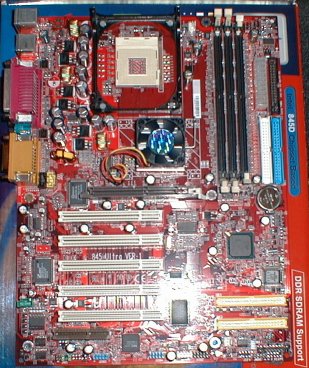
Layout is essentially identical to the 845 Pro2 with some small but crucial differences. Starting as we always do at the top left we have the dominating socket enclosure for the 478-pin Pentium 4 processor. As always, praise for Intel for blocking off the socket area and providing an excellent mounting system for the heatsinks. The clip design on a stock Intel P4 sink isn't the greatest S478 clip design and something like a Glacial Tech Igloo is easier to fit and remove but they are still a world apart from Socket A/370 clips.
Next to the socket enclosure we have the 3 DDR DIMM slots and next to them the ATX connector and floppy connector vertically aligned with the two ICH2 IDE ports right underneath, also vertically aligned. You can find ATX12 to the left of the northbridge.
From the AGP slot downwards everything is standard. The two RAID ports make an appearance on the Ultra while on the regular 845 Pro2 we tested the silkscreen and solder points were present but no physical ports or controller were present. The 6th PCI slot is removed on this board and the CNR moved up beside the 5th slot. This makes room for the extra USB headers and the USB 2.0 controller itself.
Everything else like ATX case connector, USB 1.1 headers, IrDA header and things like battery and CMOS reset jumper are all down in this area at the bottom edge of the board. Finally, the CMI chip can be found next to PCI3 on the left.
Installation was a breeze. Being a 6 mount board it replaced the outgoing 845 Pro2 without any problems and everything hooked up exactly the same. I always install the Adaptec in the last PCI slot and the NIC in PCI3 and this didn't cause any problems.
The only thing to cause problems was the DIMM bank arrangement. If you install a double sided DIMM module in DIMM2 you can't install a module in DIMM3 with the converse also being true. Using a double sided DIMM module in either DIMM2 or DIMM3 means you can't use the other. DIMM1 can take a double or single sided module without any problem and not affect the other slots due to it occupying 2 banks on the MCH. Not a great problem but something to think about when buying memory for the board.
Again, installing fans might be a problem due to there effectively only being one spare header. You get 3 on board and instantly one is claimed by the MCH fan. Using 1 for the CPU gives you 1 spare. If like me you have a PSU that uses a fan header then you have used up your fan header allocation in one fell swoop. Not a major hurdle but something to look out for if you are upgrading to this board.
BIOS, Manual and Bundle


Like the 845 Pro2, we have an Award BIOS on board with Vcore, Vdimm and Vagp adjust. You have some adjustment of DDR parameters such as CAS delay and you can force the DIMM speed if the BIOS isn't picking it up correctly from the SPD on the memory modules. Abit's TH7-II board gives a higher range of Vcore adjustments and it would be nice to see up to 2V Vcore adjust on P4 boards for overclocking since the CPU's I've tested so far seem to enjoy the extra voltage when going for higher speeds.
The manual again is usual MSI quality. Clear and easy to read with all the information needed to run the board properly. Mini guides to fitting a Socket 478 heatsink and memory modules are very welcome for the first time user. Again, the bundle itself is presented very well. You get the cool looking box, manual, driver and apps CD, the USB 2.0 backplane, D-Bracket and IDE and floppy cables. In this case you get a SmartKey USB security device in the box too. Sometimes however the SmartKey is an optional extra.
Performance
It would have been nice to have used the same 2Ghz ES processor as used in our recent Pentium 4 based reviews, however my short dalliance with the processor came to an end before the 845 Ultra arrived for review. A stock retail 1.7Ghz Socket 478 P4 processor was used for reviewing this board along with the stock Intel retail heatsink and fan. MSI make some concession towards Northwood compatibility with the statement that 2.2Ghz processors will run perfectly on the board.
Test SystemThe same test equipment used in many previews reviews. The software is identical to previous reviews with the exception of SiSoftware Sandra, this time at v2002.8.0.57. This is a BETA version of the full 2002 Retail version and the benchmark results should be no different to the new retail product upon its release. This version applies the new techniques, that have allowed comparative Athlon memory bandwidth benchmarks to increase, to the Pentium 4 platform. The benchmark now applies prefectch and buffering techniques along with full use of any advanced instruction sets on the host processor to provide us with a new memory bandwidth score. Pentium 4 scores are now comparable with Athlon scores since the same methods are used. Currently, as far as I'm aware, this new version isn't available to the public yet.
- MSI 845 Ultra ARU Intel i845 Socket 478 Motherboard
- Intel 1.7Ghz Socket 478 Retail Processor
- 2 x 256Mb Crucial PC2100 DDR CAS2.5 modules @ CAS2
- MSI G3Ti500 Pro GeForce3 Ti500 Graphics Card
- Adaptec 39160 PCI SCSI Dual Channel U160 controller
- 2 x 73Gb Seagate Cheetah 73LW U160 10,000rpm SCSI disks
- Plextor 12/10/32S SCSI CDRW
- Creative 12x IDE DVD
- Windows XP Professional Build 2600.xpclient.010817-1148
- DetonatorXP 22.40 NVIDIA drivers
- Aquamark v2.3
- Quake3 v1.30
- POVRay v3.1g.msvc.unofficial-win32 dated 28 August 2001
- 3DMark 2001 Professional
- SiSoftware Sandra v2002.8.0.57
Performance at 1.7GHz (17 x 100)
Sandra numbers first as normal. We can glean if the host CPU and important subsystems like the chipset and memory controller are working correctly at a glance by looking at Sandra's results.
CPU Arithmetic Benchmark
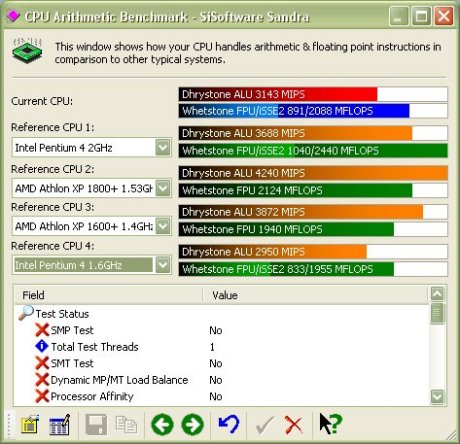
CPU Multimedia Benchmark
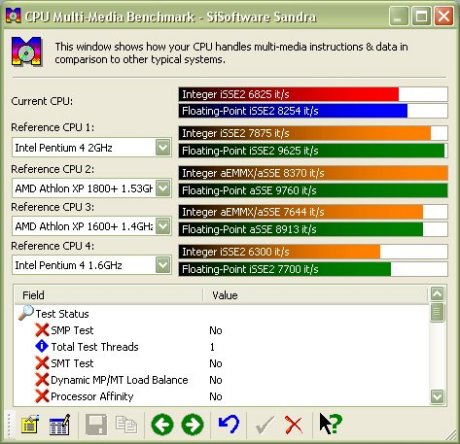
Memory Bandwidth Benchmark
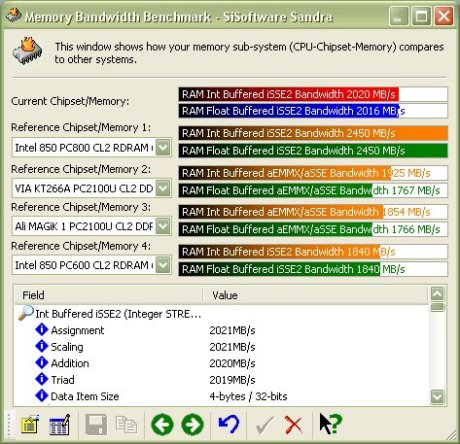
The two CPU benchmarks show that the 1.7 is running as it should. The numbers are spot on. The memory bandwidth benchmark is more interesting. The memory bus speed is 133Mhz by default due to the SPD reading the DIMM's correctly as PC2100 modules. Maximum bandwidth is 2.1Gb/sec at that speed (266Mhz DDR). If my maths isn't failing me, that's 96% efficiency. Very impressive figures for sure from the MCH.
We can see that CPU and memory are running correctly so we can proceed to our other benchmarks.
POVRay is our confirmation of Sandra's CPU benchmarks. Being a P4 system we'll have results from both P3 and P4 optimised binaries. The P4 binary shows us the kind of performance optimisation you get from a simple compiler optimisation when running code on the P4. It's also worth noting that the render output of the P4 binary is visually incorrect. The optimisation of the code produces incorrect results and the final render is slightly different from the correct rendered scene.
P3 Binary

P4 Binary

For reference, the times for a 1.8Ghz P4 processor running on an Asus P4T-E were 61s and 47s respectively. The P3 binary score looks a little low by comparison with it's 100Mhz quicker brethren however the P4 binary result is only 1s slower which is what we'd expect. We've seen P3 binary weirdness before when we reviewed DFI's i845 board when it was significantly slower than we had expected. Unfortunately we can't readily explain it. In this case it's only 4s slower to render the test scene but when the render is finished so quickly in just over 60 seconds it's a fair difference.
We use 3DMark 2001 here at Hexus for it's ability to stress a system in many areas. It is sensitive to CPU clock speed, front side bus speed, memory speed and bandwidth and card clocks. For reference here a Leadtek Ti500 clocked down to 200/460 on a 1.8Ghz i850 system scored 6950 in our labs.

We've got a 138 point advantage here despite a lower CPU clock. However we're running 240/500 GF3 clock being a Ti500 so all things being equal if we give the i845D the same CPU clock and same graphics clocks, the i850 would be ahead. The graphics clock speed advantage is worth more than the i850's 100Mhz here, hence the lead. 7000+ from a standard bench is impressive however and we shouldn't take that away from the system.
Aquamark, our second benchmark to take advantage of DirectX 8 features such as pixel and vertex shader, along with 3DMark. Aquamark absolutely needs a DX8 class card to run well otherwise performance, especially at the benchmark resolution of 1024x768 becomes sluggish.
AquaNox - AquaMark V2.3 2001/11/20 - (c) Massive Development ------------------------------------------------------------ RESOLUTION : 1024x768x32 FSAA : NONE PIXELSHADER: YES TEXTURE : 24MB SECONDS : 46.53 ...... MIN FPS : 34.7 MAX FPS : 67.0 AVG FPS : 48.4For reference, our comparison i850 + RAMBUS + P4 1.8GHz + 200/460 GeForce3 scores 49.51. The higher memory bandwidth and CPU clock have the slight advantage over increased card clocks here. There is really nothing in it here between the two systems.
So we can see that stock performance, especially in the 3D applications is similar in performance to the i850/RAMBUS/GF3/1.8Ghz P4 combo we've been using to gauge performance. Performance in the 3D applications is significantly higher than an SDR P4 with a 2Ghz P4 showing just how much memory bandwidth helps despite the disadvantage of outright core speed.
Overclocked performance
After having the extremely flexible 2Ghz ES processor that could run at a huge range of clock speeds and front side bus speeds due to having access to any multiplier, the inflexibility of a locked multiplier CPU is a burden. However in the case of an Intel P4 system where 99.9% of people have a locked multiplier CPU it becomes a valid test that more people can relate to.
This particular test processor has successfully been benchmarked at 2090Mhz on a TH7-II where the CPU had access to 2.2V Vcore. However on the MSI we are limited to 1.85V maximum and the processor was less inclined to perform. I managed a totally stable benchmark clock of 1921Mhz (17 x 113). Maybe MSI will be more inclined to release boards with higher Vcore adjust in the future, maybe via an overclockers BIOS or something similar. It would certainly have allowed me to unlock the rest of the CPU's potential.
As always, Sandra numbers first.
CPU Arithmetic Benchmark
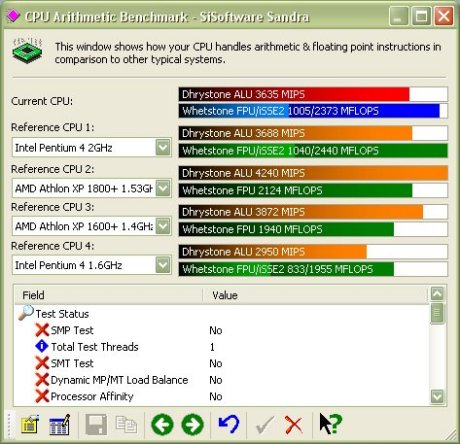
CPU Multimedia Benchmark
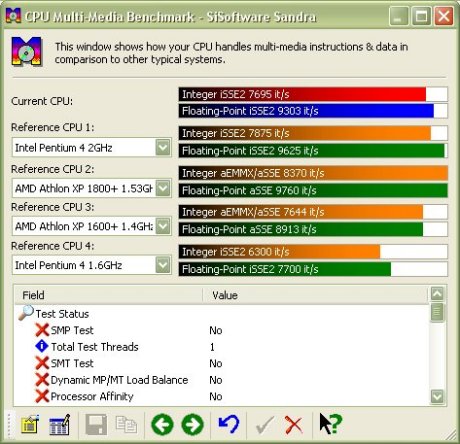
Memory Bandwidth Benchmark

The memory bandwidth benchmark shows us the fruits of running at 146Mhz memory bus speed. 2.2Gb/sec is what we'd expect. Nothing exciting here, just Sandra confirming that everything is working properly and as it should be. Next up we use POVRay to confirm things on the CPU side.
P3 Binary

P4 Binary

Here we see the P4 @ 1.92 overtake the 1.8Ghz in the P4T-E and sneak up on the various 2Ghz results we've seen over the past weeks in our other P4 based reviews using the i845 boards. Performance is solid and exactly where it should be. Nothing majorly exciting.
3DMark 2001 next. It should respond well to the extra memory bandwidth and CPU speed that comes from overclocking the front side bus. Lets see how we get on.

Remember all that's changed here is the CPU clock, memory clock and system front side bus speed and not by a huge amount either. The large CPU multiplier helps the CPU clock go a bit higher than say with a low multiplier AMD system but it's not a staggering overclock. The extra points total is higher than I had estimated for the clocks (estimated around the high 73xx's). All in all a nice free boost in speed from some simple FSB overclocking. Being 113Mhz FSB, PCI devices are close enough to specification that only the most sensitive PCI devices will have trouble. This makes the P4 a pain to overclock and also a joy. Low FSB keeps the system close to spec but lack of multiplier choice stops us from running 133Mhz FSB which on this board should keep our devices exactly in specification and give us a free speed boost for the same CPU speed.
Lastly Aquamark. Our DX8 bench is a good test of overall performance. Remember, just FSB, mem clock and CPU clock change here.
AquaNox - AquaMark V2.3 2001/11/20 - (c) Massive Development ------------------------------------------------------------ RESOLUTION : 1024x768x32 FSAA : NONE PIXELSHADER: YES TEXTURE : 24MB SECONDS : 44.22 ...... MIN FPS : 33.3 MAX FPS : 67.5 AVG FPS : 51.1Scores over 50fps are rare around these parts, especially at standard card clocks. Quite an impressive increase for Aquamark considering how little we did to get there. Overclocking the FSB overclocks pretty much everything and the system gets a nice speed boost into the bargain. It's just a shame we couldn't go any higher without some instability creeping in.
Before we head to the conclusions, here's a screenshot of WCPUID to prove the speeds.
So, overclocked performance was excellent when looking at the 3D games based benchmarks that we run. i845-D starts to move up a gear when you overclock the system and overall system performance at 113Mhz FSB was great. The whole system benefited from the increase. Only CPU core voltage stopped us from going higher as all the components were known to go higher and the FSB was certain to go higher still. The Vdimm and Vagp adjust could help a few people out of a tight spot overclocking wise.
Conclusion
So does i845-D have any place in the P4 world and does MSI's implementation with added features stay pegged up there with their other impressive motherboards of late?
I'd have to say yes to the first question. For a lot of people who wouldn't by RAMBUS for whatever reason but would also not buy a P4 SDR system due to low performance, Intel officially releasing a DDR chipset is an enabler onto the platform for many people. It offers a performance level slightly under that of i850 and RAMBUS and gets the crucial technology into play that most people are a huge fan of. DDR memory is cheap, available and proven and lets people reuse an existing investment they are almost bound to have, especially if they are coming from any recent AMD system.
I'm a big fan of the processor and while I believe it needs clock speed to really show it's potential, a fast P4 combined with some fast DDR is my ideal P4 platform.
MSI has taken the chipset and ran with it on this motherboard. New technologies, especially USB 2.0, are a welcome inclusion and ATA133 RAID will keep some people happy who have invested in some new IDE disks. With MSI seemingly taking advice from the hardware enthusiasts and allowing more adjustment of the settings on board it can start to build on creating boards for the enthusiast too, a market that maybe MSI has missed out on in the past.
As you might know, I'm also a fan of the C-Media onboard PCI sound that MSI are so happy to place on board instead of using the AC'97 audio on a southbridge. Long may that continue.
Presentation is another MSI strong point and they deliver yet again. D-Bracket and SmartKey are also value additions to the package.
The board hasn't yet launched here in the UK, at least not at my usual source of MSI outlets like Komplett. As soon as we get a proper word on price we'll update you. I can take an educated guess however and estimate it to be around £135 to £160 when it finally appears, depending on retailer. It seems the answer to our second question is now also yes!
Overall, we're happy to award the board the Hexus Editors Choice Award. We've had quite a few Socket 478 boards at Hexus over the last few weeks and this is the first board to really stand out. It was a pleasure testing and using the board and when I find a new CPU I'll make it a fixture in my system permanently. Well done Intel and especially well done MSI.














